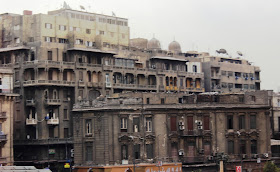Mount Nebo, a 11,929-foot massif at the southernmost end of Utah's Wasatch Range, looms over Nephi, Utah, a town thirty miles away from where I grew up.
Its imposing presence is reflected in the number of things named after it: the Nebo Scenic Byway, the Mount Nebo Wilderness, the Nebo Credit Union, and even Nebo School District, source of my excellent education. Utah's main north-south freeway runs right past Mount Nebo, and I've driven that stretch hundreds of times. My husband and one of our sons have climbed Mount Nebo and deemed it a pretty rigorous hike.
Understandably, I was more than ready to meet the archetypal Mount Nebo, a somewhat more stooped 2,680 feet-above-sea-level hump.
This looks like Moses to me:
Understandably, I was more than ready to meet the archetypal Mount Nebo, a somewhat more stooped 2,680 feet-above-sea-level hump.
Just like many of the Biblical sites in Israel, this one is being cared for by the Franciscans. As I think about it now that I am back home, I wonder how the Jews and Muslims feel about Christian control of this site. Mount Nebo was Moses's last stop on his exceedingly long journey from Egypt to the Promised Land, a series of events that is a significant part of Jewish and Muslim tradition as well as Christian tradition. Some (but not all) members of all three traditions also believe Moses is buried somewhere on this mountain. It is not just a "Christian Holy Place."
However, until the Franciscans came in 1933, there was nothing at this site. Our guide told us that the Franciscans asked King Abdullah for the mountain, and he bought it and gave it to the them. They are responsible for all the work here, so I guess that gives them some rights.
Pope John Paul II chose Mount Nebo as the place to kick off his pilgrimage to the Holy Land in March 2000. Maybe he was trying to symbolically continue the journey that, for Moses, halted here almost 3300 years ago. Like Moses, he got a pretty good look at the Promised Land from Mount Nebo's summit, but unlike Moses, he got to continue on.
 |
| Photo of photo at site |
During his visit, he planted an olive tree as a symbol of peace:
There is also a wonderful statue of Moses that was installed in 2000 and dedicated to Pope John Paul II:
 |
| The Latin inscription on the side reads, "One god, father of all, over all." |
Seen head-on, the sculpture looks like a book, each strand of Moses's hair and beard a page:
An up-close look at the lower portion shows smaller books, as if on a shelf:


















































